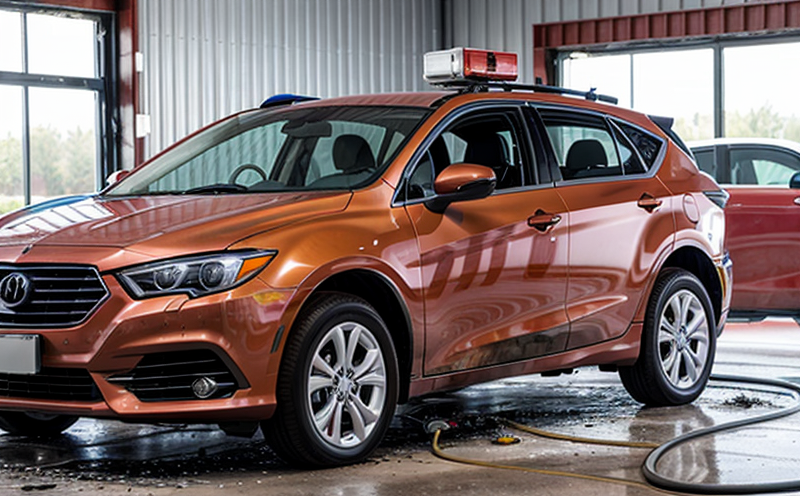Heat and Smoke Release Analysis in Automotive Fires
In automotive fire safety testing, heat and smoke release analysis plays a critical role in ensuring vehicular safety. This service is essential for understanding the behavior of materials under high-temperature conditions, which can lead to significant risks during fires.
The process involves simulating real-world fire scenarios to assess how various components behave when exposed to intense heat and flames. The goal is to identify potential hazards that could exacerbate a fire or release harmful substances into the environment. This analysis helps in designing safer vehicles by identifying materials with lower smoke and heat release characteristics, thus minimizing risks to passengers and reducing environmental impact.
Automotive components such as upholstery, trim, and structural parts are subjected to rigorous testing to determine their flame spread index (FSI) and smoke density. The FSI measures the rate at which a material ignites and propagates fire, while smoke density is crucial for understanding how much smoke will be released into an enclosed space during a fire.
For accurate analysis, specimens are prepared according to international standards such as ISO 5660-2:2017 or ASTM E648. These specifications ensure that the testing conditions replicate real-world scenarios accurately. The test apparatus includes a heating device, a combustion chamber, and sensors for measuring temperature, smoke density, and other critical parameters.
The data collected during these tests is meticulously analyzed to provide insights into material behavior under fire conditions. This information helps manufacturers make informed decisions about material selection, design improvements, and compliance with regulations like the European Union’s ECE R94/05 standard for vehicle safety.
Understanding heat and smoke release characteristics is not just a matter of ensuring passenger safety but also contributes significantly to environmental sustainability. By minimizing smoke emissions during fires, we reduce air pollution and its associated health risks. This service supports the broader goal of creating more sustainable vehicles that are safer and kinder to the environment.
- Reduction in fire risk: Identifying materials with low heat release rates helps prevent fires from spreading rapidly.
- Lower smoke emissions: Materials that release less smoke during a fire contribute to cleaner air and reduced health impacts.
Why It Matters
The importance of heat and smoke release analysis in automotive fires cannot be overstated. Automotive fires are one of the leading causes of vehicle-related fatalities, with poor material selection being a significant contributing factor. By conducting this analysis, manufacturers can significantly enhance safety standards and reduce the risk of fire incidents.
Smoke released during a fire can have severe health implications for passengers trapped in the vehicle. High smoke densities can lead to respiratory issues and other health problems. Therefore, ensuring that materials used in automotive interiors are designed with minimal smoke release is crucial. This not only protects occupants but also contributes positively to public health.
Furthermore, environmental considerations play a vital role in this analysis. Fires in vehicles can occur accidentally or during accidents, releasing harmful substances into the atmosphere. By minimizing smoke and heat emissions, we help reduce the overall carbon footprint of automotive products. This aligns with global efforts towards sustainability and cleaner air.
Automotive manufacturers are under increasing pressure to comply with stringent safety regulations, such as those set by the European Union’s ECE R94/05 standard. These regulations mandate that vehicles must meet certain fire resistance criteria, including heat and smoke release limits. Compliance with these standards is essential for market access and consumer trust.
In addition to safety and environmental benefits, this analysis also aids in product development by providing valuable data on material performance under extreme conditions. This information can be used to improve designs, enhance durability, and increase overall vehicle safety.
Eurolab Advantages
At Eurolab, we pride ourselves on offering comprehensive heat and smoke release analysis services tailored specifically for the automotive industry. Our team of experts ensures that every test is conducted with precision and accuracy, providing reliable data that can be trusted in regulatory compliance.
- Comprehensive expertise: Our staff has extensive experience in fire safety testing, allowing us to offer comprehensive analysis across various materials used in automotive interiors.
- State-of-the-art equipment: We utilize cutting-edge test apparatus that meets the highest international standards, ensuring consistent and repeatable results.
- Regulatory compliance: Our services are designed to meet all relevant European Union regulations, providing peace of mind for manufacturers seeking market access.
We understand the unique challenges faced by automotive manufacturers when it comes to fire safety testing. Our approach is holistic, focusing not only on immediate safety concerns but also on long-term sustainability goals. By working closely with clients throughout the testing process, we ensure that every aspect of material performance is thoroughly evaluated.





